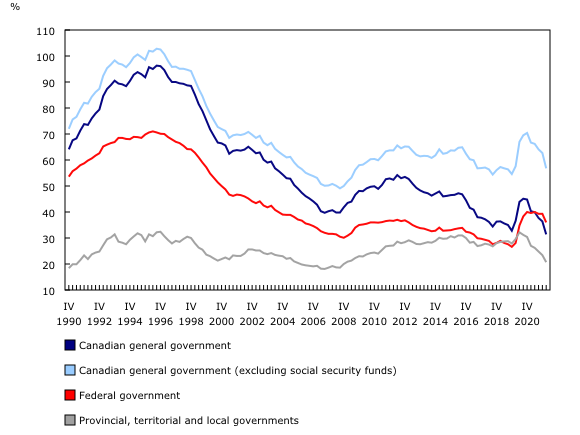Government finance statistics, first quarter 2022
Released: 2022-07-04
Tax revenues reach new highs, contributing to deficit reduction
The Canadian general government recorded a deficit of $17.0 billion in the first quarter of 2022. Tax revenues continued to grow (+8.3%) to reach $188.0 billion, linked to sustained growth in nominal gross domestic product (GDP), while retroactive salary adjustments tempered the improvement in the net operating balance. Compared with the first quarter of 2021, the deficit fell by $28.8 billion, mainly attributable to the federal government.
The net operating balance is the difference between revenues and expenses for a given period and is a summary measure of the sustainability of government operations. When revenues are lower than expenses, a deficit is recorded, while the reverse induces a surplus.
As a percentage of nominal GDP, the deficit in the first quarter of 2022 was 2.7%. Despite the increase from the previous quarter (1.8% of the GDP), the deficit has narrowed sharply since the historic 21.6% peak recorded in the second quarter of 2020. The resumption in economic growth and the gradual decline in federal government transfer spending related to the COVID-19 pandemic have both contributed significantly to the reduction of the deficit in recent quarters.
Net debt as a percentage of gross domestic product falls below pre-pandemic levels
Net debt of the Canadian general government, defined as the difference between total liabilities and total financial assets in the public accounts (or the reverse of net financial worth), decreased by $95.6 billion in the first quarter of 2022 from the first quarter of 2021 to stand at $804.7 billion. The decline was mainly due to the increase in the value of financial assets held by governments in the last year (+12.9% compared with the first quarter of 2021), which was considerably higher than the growth rate of liabilities (+6.3%).
As a result, in the first quarter of 2022, the relative weight of net debt to GDP of the Canadian general government was 31.4%, compared with 32.8% before the pandemic (i.e., at the end of the fourth quarter of 2019). Excluding social security funds (Canada Pension Plan and Quebec Pension Plan), whose financial assets are intended to pay for future public retirement plan benefits, the net debt-to-GDP ratio reached 56.8% in the first quarter of 2022, compared with 54.6% at the end of the fourth quarter of 2019.
Debt refinancing needs remain high for the federal government
In the first quarter of 2022, federal government debt in the form of debt securities amounted to $1,230.1 billion. Although relatively stable in recent quarters, the debt issued on the markets is well above pre-pandemic levels (+$443.5 billion, compared with the fourth quarter of 2019). Based on outstanding debt securities at the end of the first quarter of 2022, the federal government's debt refinancing needs amounted to $617.2 billion by the end of 2024, or 49.4% of the total outstanding debt securities.
Accordingly, the recent reorientation of the Bank of Canada's monetary policy (quantitative tightening and increase in the policy interest rate) to curb inflation could result in a significant increase in the federal government's borrowing costs. The federal government's ratio of interest expense to revenue in the first quarter of 2022 hit a low of 5.8%, from the peak of 38.1% recorded in the first quarter of 1991.
Note to readers
Quarterly financial data for the Canadian general government and its subsectors from the first quarter of 1990 to the first quarter of 2022 are now available. These subsectors include the federal government, provincial and territorial governments, local governments and the Canada and Quebec Pension Plans.
Government Finance Statistics (GFS) presents fiscal statistics using the standard developed by the International Monetary Fund. This standard allows consistent aggregation and analysis between participating countries.
Currently, GFS quarterly data are derived by mapping Canada's System of National Accounts data to GFS standards and conventions.
This release of GFS includes revised data for the first quarter of 2021 to the fourth quarter of 2021.
Products
Additional information can be found in the Latest Developments in the Canadian Economic Accounts (13-605-X). The User Guide: Canadian System of Macroeconomic Accounts (13-606-G) is also available. This publication has been updated with Chapter 9. Government Finance Statistics.
Contact information
For more information, or to enquire about the concepts, methods or data quality of this release, contact us (toll-free 1-800-263-1136; 514-283-8300; infostats@statcan.gc.ca) or Media Relations (statcan.mediahotline-ligneinfomedias.statcan@statcan.gc.ca).
- Date modified:



